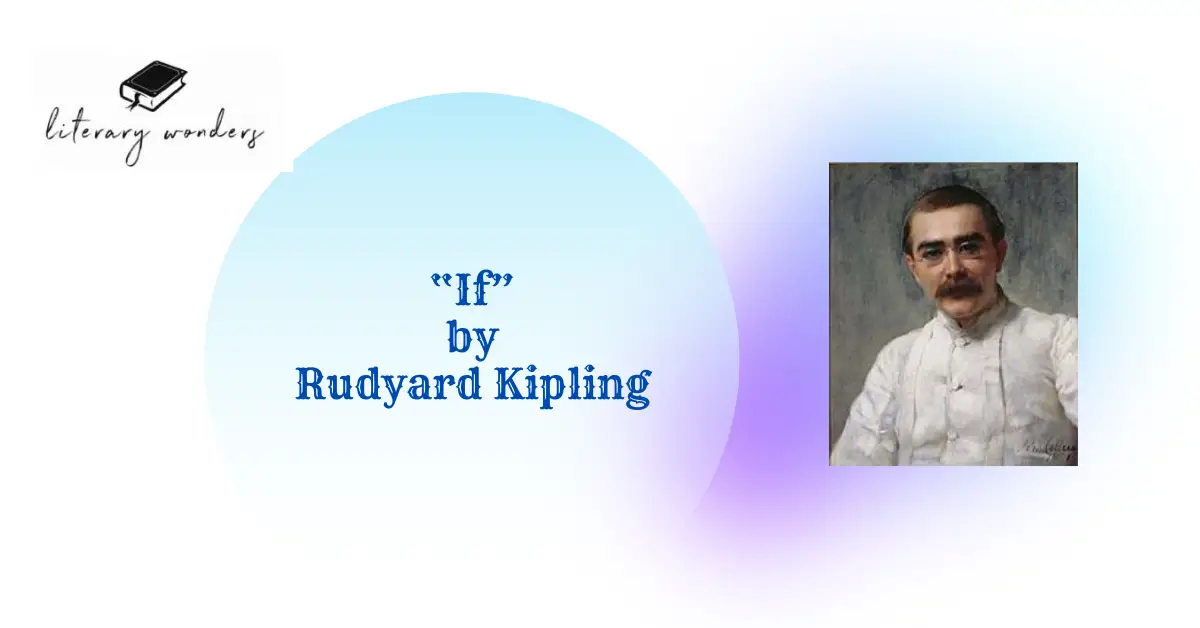“If” by Rudyard Kipling Analysis
Summary of the Poem, “If”
- Introduction of “If” by Rudyard Kipling: “If” by Rudyard Kipling, a famous essayist and poet is a suggestive poetic piece. Kipling wrote this poem to pay tribute to his friend, Leander Starr Jameson. Although the poem was written in 1895, it was printed in 1910. Kipling advises his friend to keep himself poised, and dreams of the future. He suggested to his friend that he should keep control of his nerves if he wants to be successful in the future. This universal piece of advice has made this poem popular worldwide.
- “If” As a Representative of Care: This symbolic poem revolves around the golden piece of advice that the poet gives to his friend while counting several strategies. He starts by saying that his friend should keep his head high in the face of adversity. Second, he suggests that he should always speak the truth even when others prefer to tell lies. Also, when others are waiting, he should join them to look wise and astute. The poem then shifts his focus and talks about dreams stating that he should master his dreams and plan things effectively in catastrophic situations. He further advises him not to lose heart while comforting various failures. To him, failure provides an opportunity to start something again, avoiding errors. He further advises him not to lose his temper and to remain peaceful when surrounded by real figures. In his opinion, if his friend becomes balanced, calm, and sagacious in the most troublesome moments, then he is the man and only then the world will offer him a chance to be ruled.
- Major Themes in “If” by Rudyard Kipling: Dreams, balanced thinking, optimism, and care mark the center of the poem. Kipling starts this poem while highlighting the importance of balanced thinking, advising his readers that if they keep their heads high during trying times, they can be counted as wise, moderate, and sagacious. He goes on to explain the importance of dreams and having a spirit to achieve those dreams. To him, only great spirits dare to dream and then move in the direction of achieving them. Similarly, when a person remains steadfast in life even after facing troubles and adverse circumstances and does not become touchy or irritating, it means that he has attained the desired maturity in life. This also means that he never loses his heart and can shine even after facing multiple failures. This is how a person becomes steadfast and most importantly an ideal masculine figure.
Analysis of Poetic Elements Used in “If”
Literary and poetic devices are tools that writers use to make their poems more compelling. Their appropriate use brings depth, and a layer of meanings in seemingly simple poetic pieces. Rudyard Kipling has also used various poetic elements in this poem to make it a universal marvel.
- Assonance: The repeating of vowel sounds in a line is known as assonance. Examples of this are the sounds /e/ in “Are losing theirs and blaming it on you” and /o/ in “Or being lied about, don’t deal in lies.”
- Anaphora: This is the term used to describe how certain verses repeat a word or phrase in the first section. Kipling emphasized certain points in the poem by using the word “if” throughout the poem.
- Consonance: Consonance is the repeating of consonant sounds in a line. Examples of consonant repetitions are the sounds /t/ in “If you can meet with Triumph and Disaster” and /n/ in “If you can force your heart and nerve and sinew.”
- Diction: The poem uses powerful imagery, symbolism, and rhetorical tactics to create descriptive diction.
- End Rhyme: The stanza is made melodic by the employment of end rhyme. In this poem, Kipling employs end rhymes like “loss/toss,” “gone/on,” and “fools/tools.”
- Irony: Irony is a figure of speech where words are employed in a way that contrasts their intended meaning with their actual meaning. The poem illustrates the irony of how certain practices can make a person the greatest of all.
- Imagery: Readers can see things through their five senses through the use of imagery. In this poem, Rudyard Kipling makes use of imagery from lines like “If you can make one heap of all your winnings,” “And never breathe a word about your loss,” and “Except the Will which says to them: ‘Hold on.”
- Metaphor: This is a figure of speech in which two objects with differing natures are impliedly compared. The poem illustrates how man’s revolutionary thoughts can change everything by using revolution as an extended metaphor.
- Symbolism: Symbolism refers to the application of symbols to represent concepts and attributes, endowing them with meanings that deviate from their literal interpretations. The poem uses symbols like dream, change, and care as symbols.
The analysis shows that the accurate insertion of these devices has made it easy for the readers to understand the underlying meanings of the poem.
Suggested Readings

